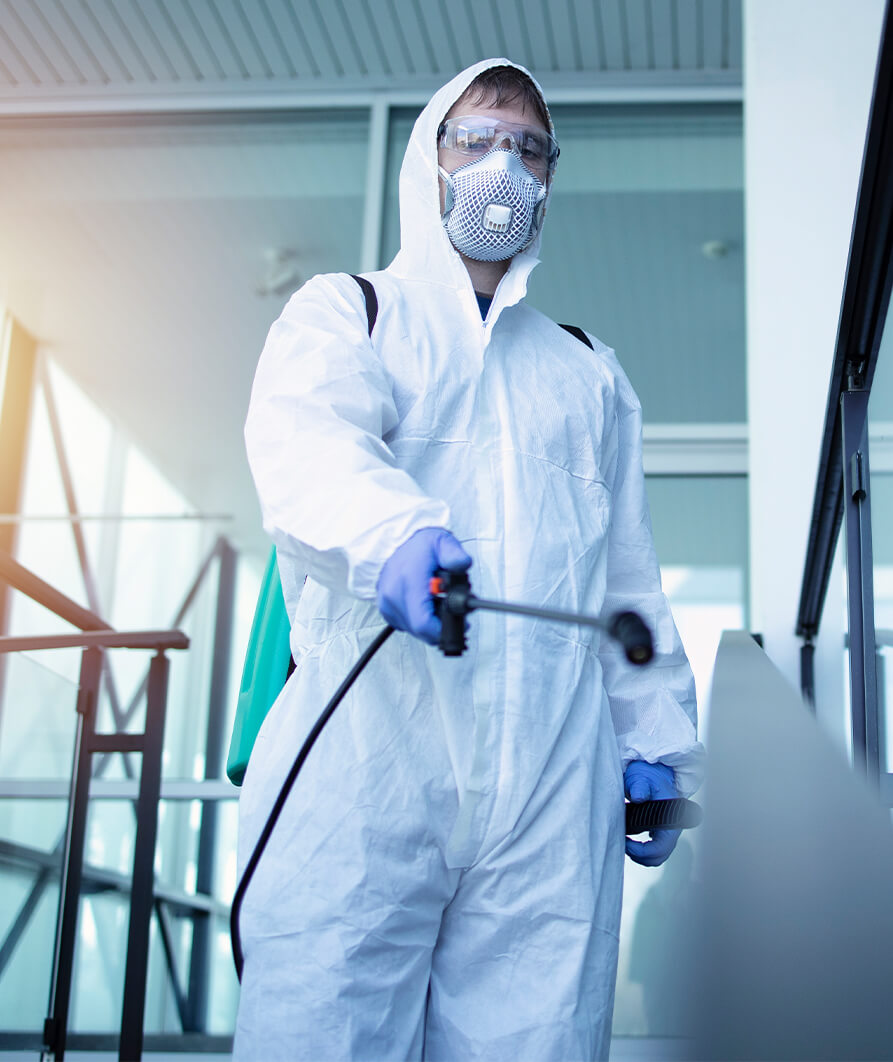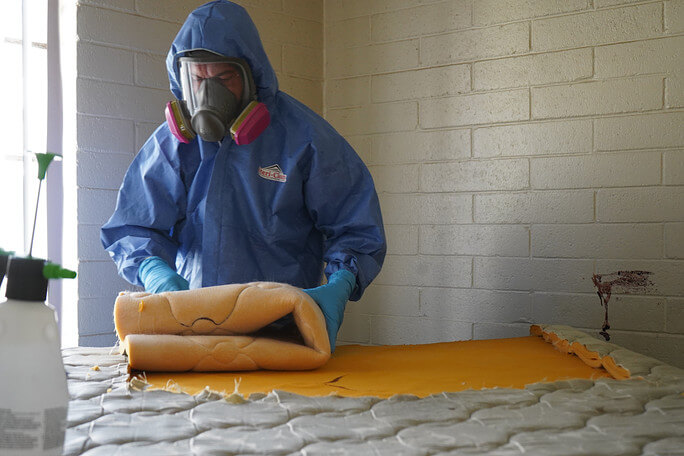Mold Remediation Solutions: Protecting Your Residential Or Commercial Property from Mold And Mildew Damage
Mold Remediation Solutions: Protecting Your Residential Or Commercial Property from Mold And Mildew Damage
Blog Article
Professional Biohazard Cleaning and Decontamination for Blood, Bodily Fluids, and Hazardous Materials
The possible health and wellness risks linked with exposure to biohazards highlight the crucial demand for careful handling and complete cleanup. As we browse the complex landscape of biohazard clean-up, understanding the nuances of laws, compliance, and the customized tools at play comes to be crucial in guaranteeing a complete and safe purification process.
Wellness Dangers of Biohazard Direct Exposure
Direct exposure to biohazards presents substantial wellness threats that can result in severe repercussions for communities and individuals alike. Biohazards incorporate a large range of organic materials, including blood, bodily fluids, mold and mildew, microorganisms, viruses, and other potentially contagious materials. When individuals come into contact with these biohazards, whether with mishaps, inappropriate handling, or environmental exposure, they face the danger of having significant illnesses or illness.
Among the main health and wellness dangers related to biohazard direct exposure is the transmission of infectious conditions. Bloodborne microorganisms such as HIV, hepatitis B and C, and numerous germs can be present in biohazardous materials, posturing a direct hazard to human health and wellness. Inhaling airborne biohazards like mold and mildew spores or entering call with polluted surfaces can also lead to respiratory system problems, allergies, and various other unfavorable health and wellness results.
In addition, biohazard exposure can have lasting health implications, with some conditions materializing years after the first call (Blood Cleanup). As a result, it is vital to prioritize proper biohazard cleansing and purification to minimize these wellness threats and ensure the safety of individuals and communities

Specialized Training for Biohazard Cleanup
When it involves handling biohazard cleanup efficiently and securely, specialized training plays an essential role in ensuring correct decontamination procedures are adhered to. Biohazard clean-up requires certain knowledge and abilities to successfully alleviate threats connected with bloodborne pathogens, physical liquids, and unsafe materials. Specialists learnt biohazard cleanup undertake extensive instruction on how to securely deal with, eliminate, and dispose of biohazardous materials to stop contamination and exposure.
Specialized training for biohazard cleaning covers a series of necessary subjects, consisting of proper personal protective devices (PPE) use, bloodborne microorganism understanding, purification methods, and contaminated materials disposal procedures. People educated in biohazard cleaning are furnished with the required experience to evaluate contamination levels, identify prospective risks, and execute appropriate cleaning treatments in conformity with regulatory criteria.
Continual training and education are critical in the field of biohazard cleanup to stay upgraded on the current decontamination innovations, security protocols, and regulations. By buying specialized training, biohazard cleanup specialists can properly react to emergency situation cleaning circumstances and guard both public wellness and the atmosphere.
Importance of Proper Purification Methods
Using correct purification methods is critical in biohazard clean-up to properly remove unsafe materials and decrease health and wellness threats. Effective purification not only makes sure the elimination of visible traces of blood, bodily fluids, and other biohazards but likewise targets invisible virus that might position major wellness threats otherwise effectively eradicated. By complying with rigid purification protocols, trained experts can dramatically lower the threat of direct exposure to unsafe bacteria, viruses, and bacteria that can cause illness or infections.
Appropriate purification strategies involve the use of specific equipment and anti-bacterials that are specifically made to reduce the effects of biohazards successfully. Comprehensive cleansing and disinfection of infected locations are essential to protect against the spread of microorganisms and guarantee a risk-free environment for owners. Additionally, the correct disposal of biohazardous waste adhering to decontamination treatments is essential in avoiding contamination of various other surfaces or people.

Equipment and Devices for Safe Cleanup
The appropriate devices and tools play a critical role in making sure the secure and reliable clean-up of biohazardous materials. When managing blood, bodily look what i found fluids, or hazardous products, biohazard cleaning professionals rely upon specialized gear to decrease exposure risks and extensively decontaminate the affected location. Individual protective equipment (PPE) such as handwear covers, coveralls, masks, and safety glasses are important to shield against straight contact with possibly transmittable materials. In addition, biohazard cleansing packages having disinfectants, absorptive materials, and biohazard bags are used to securely contain and get rid of of polluted things. Blood Cleanup.
Advanced cleaning devices like hospital-grade disinfectants, HEPA-filtered vacuums, and fogging equipments are used to disinfect surfaces and get rid of biohazards efficiently. Specialized devices such as sharps containers and biohazard garbage disposal bins are used to securely handle sharp objects and biohazardous waste materials. By utilizing the appropriate equipment and tools, biohazard cleansing professionals can make certain a complete clean-up process that prioritizes security and minimizes wellness dangers for both employees and residents of the affected room.
Rules and Conformity in Biohazard Cleaning
Proper adherence to guidelines and conformity requirements is paramount in biohazard cleansing to make certain the safety of both employees and the environment. Federal government agencies such as OSHA (Occupational Safety And Security and Wellness Management) and the EPA (Epa) have established particular standards for biohazard cleanup treatments to lessen health risks and ecological contamination. These policies cover a range of facets consisting of the handling, transportation, and disposal of biohazardous products, along with the needed training and protective devices needed for employees associated with the cleanup process.
Biohazard cleaning companies need to remain current with these regulations to guarantee that their operations meet the required safety and security standards. Failing to follow these regulations can cause extreme effects, consisting of fines, legal activity, and threatening the health and wellness of individuals and the atmosphere. By complying with rigid laws and conformity actions, biohazard cleansing companies can efficiently alleviate risks and make certain a complete and safe cleanup procedure for all parties included.
Final Thought
To conclude, biohazard cleaning and purification require customized training, proper methods, and adherence to policies. Direct redirected here exposure to blood, physical liquids, important site and unsafe materials presents significant health and wellness threats, making it vital to utilize the right devices and tools for secure cleanup. By complying with rigorous procedures and standards, specialists can effectively reduce the risks connected with biohazard direct exposure and make sure the safety and security of both themselves and others.
As we browse the complex landscape of biohazard clean-up, understanding the nuances of policies, compliance, and the specialized devices at play becomes vital in guaranteeing a detailed and secure decontamination procedure. (Blood Cleanup)
When it comes to handling biohazard clean-up successfully and safely, specialized training plays a fundamental duty in making sure appropriate decontamination procedures are followed.Using correct decontamination techniques is crucial in biohazard clean-up to successfully reduce and get rid of unsafe materials health and wellness risks. In addition, biohazard cleaning packages including anti-bacterials, absorbent materials, and biohazard bags are made use of to safely dispose and consist of of infected things.
Federal government companies such as OSHA (Occupational Security and Wellness Administration) and the EPA (Environmental Protection Agency) have developed certain guidelines for biohazard cleanup treatments to reduce health and wellness risks and environmental contamination.
Report this page